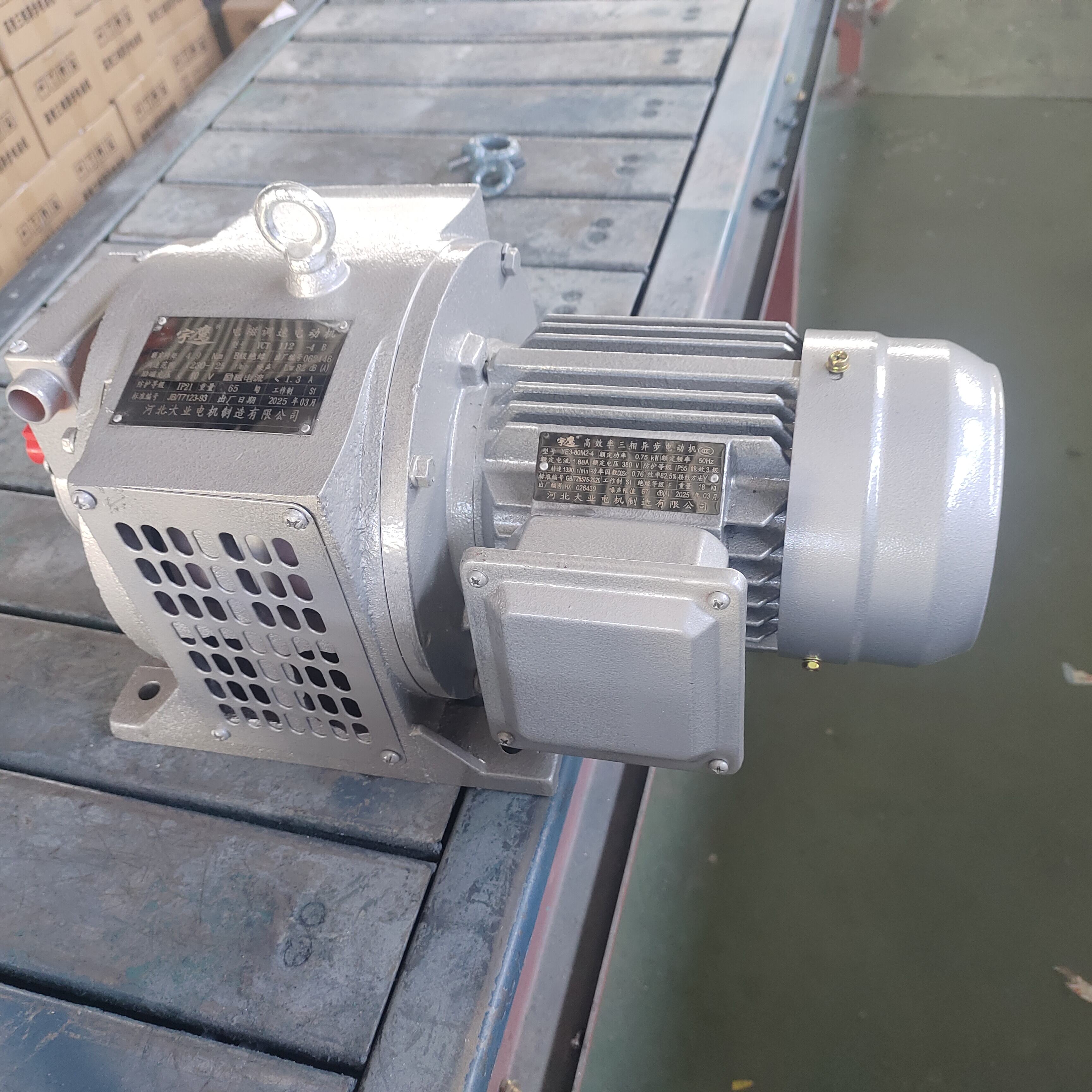The manufacturing landscape is experiencing a revolutionary transformation as we advance through 2025, with industrial motor technology at the forefront of innovation. Modern manufacturing facilities are increasingly dependent on advanced motor systems that deliver superior efficiency, reliability, and performance across diverse applications. The evolution of industrial motor technology reflects broader trends in automation, sustainability, and smart manufacturing practices that define today's competitive industrial environment. These technological advances are reshaping how manufacturers approach production efficiency, energy consumption, and operational reliability in ways that were unimaginable just a decade ago.

Advanced Motor Technologies Driving Manufacturing Excellence
Permanent Magnet Synchronous Motors Revolution
Permanent magnet synchronous motors represent one of the most significant technological breakthroughs in industrial motor design for 2025. These motors offer exceptional efficiency ratings exceeding 96% in many applications, dramatically reducing energy consumption compared to traditional induction motors. The integration of rare-earth magnets creates powerful magnetic fields that enable precise speed control and torque delivery across variable load conditions. Manufacturing facilities implementing these motors report substantial reductions in operational costs while achieving superior performance metrics that enhance overall productivity.
The compact design of permanent magnet motors allows for space-efficient installations in crowded manufacturing environments. Their reduced heat generation extends operational lifespan and minimizes cooling requirements, contributing to lower maintenance costs and improved reliability. Advanced control algorithms paired with these motors enable unprecedented precision in positioning applications, making them ideal for robotics, CNC machinery, and automated assembly systems.
Variable Frequency Drive Integration
Variable frequency drives have become integral components of modern industrial motor systems, enabling dynamic speed control and energy optimization across diverse manufacturing processes. These sophisticated control systems analyze real-time load conditions and automatically adjust motor speed and torque output to match operational requirements precisely. The result is significant energy savings, reduced mechanical stress on equipment, and extended motor lifespan that translates to lower total cost of ownership.
Contemporary VFD technology incorporates advanced algorithms that predict maintenance needs and optimize performance parameters continuously. Smart diagnostic capabilities monitor motor health indicators such as vibration patterns, temperature fluctuations, and current consumption to prevent unexpected failures. This predictive maintenance approach allows manufacturers to schedule maintenance activities during planned downtime, minimizing production disruptions and maximizing equipment availability.
Energy Efficiency and Sustainability Initiatives
IE5 Efficiency Standards Implementation
The introduction of IE5 efficiency standards marks a pivotal moment in industrial motor development, establishing new benchmarks for energy performance that exceed previous generations by significant margins. These ultra-premium efficiency motors deliver energy savings that can reduce electrical consumption by 15-20% compared to IE3 standard motors. Manufacturing facilities adopting IE5 compliant systems experience immediate reductions in operating costs while contributing to corporate sustainability goals and environmental stewardship initiatives.
Implementation of IE5 standards drives innovation in motor design, materials science, and manufacturing processes. Advanced magnetic materials, optimized winding configurations, and precision manufacturing techniques combine to achieve these exceptional efficiency levels. The long-term benefits extend beyond energy savings to include reduced carbon footprint, improved power factor, and enhanced grid stability for industrial facilities.
Regenerative Braking Systems
Regenerative braking technology transforms traditional energy-wasting braking processes into energy recovery opportunities that contribute to overall system efficiency. When an industrial motor decelerates, regenerative systems capture kinetic energy and convert it back to electrical energy for reuse within the facility. This technology proves especially valuable in applications involving frequent start-stop cycles, vertical movement, or variable speed operations where traditional braking methods waste substantial energy.
Modern regenerative braking systems incorporate sophisticated power electronics that seamlessly manage energy flow between motors, drives, and facility power systems. The recovered energy can power other equipment, charge energy storage systems, or feed back into the electrical grid. Manufacturing facilities implementing regenerative braking report energy cost reductions of 10-30% in applicable applications while reducing heat generation and extending brake component lifespan.
Smart Manufacturing and IoT Integration
Condition Monitoring and Predictive Analytics
Internet of Things integration transforms industrial motor systems into intelligent components that continuously communicate operational status, performance metrics, and health indicators to centralized monitoring systems. Advanced sensor networks monitor critical parameters including temperature, vibration, electrical characteristics, and load conditions in real-time. This comprehensive data collection enables sophisticated analytics platforms to identify performance trends, predict potential failures, and optimize operational parameters automatically.
Machine learning algorithms analyze historical performance data to establish baseline operating parameters and detect anomalies that might indicate developing problems. These predictive analytics capabilities allow maintenance teams to address issues before they result in unexpected failures or production disruptions. The integration of artificial intelligence enables continuous optimization of motor performance based on changing operational conditions and load requirements.
Remote Monitoring and Control Capabilities
Cloud-based monitoring platforms enable manufacturers to oversee motor performance across multiple facilities from centralized control centers. These systems provide real-time visibility into operational status, energy consumption, and performance metrics for entire motor populations. Remote diagnostic capabilities allow technical specialists to troubleshoot issues, adjust parameters, and optimize performance without physical presence at facility locations.
Advanced cybersecurity measures protect industrial motor control systems from potential threats while enabling secure remote access for authorized personnel. Encrypted communication protocols and multi-factor authentication ensure data integrity and system security. Mobile applications provide facility managers with instant access to critical information and emergency notification capabilities that enable rapid response to operational issues.
Application-Specific Motor Innovations
Explosion-Proof Motor Developments
Hazardous environment applications drive specialized motor designs that maintain safety standards while delivering improved performance and reliability. Modern explosion-proof motors incorporate advanced enclosure designs, specialized materials, and enhanced cooling systems that enable operation in challenging industrial environments. These motors meet stringent safety certifications while providing the performance characteristics required for demanding applications in chemical processing, petroleum refining, and mining operations.
Temperature management systems in explosion-proof motors utilize innovative cooling technologies that maintain safe operating temperatures without compromising containment integrity. Advanced bearing systems and lubrication technologies extend maintenance intervals and improve reliability in harsh operating conditions. These specialized motors often incorporate condition monitoring capabilities that provide early warning of potential issues while maintaining safety compliance.
High-Speed Motor Applications
High-speed industrial motor applications require specialized designs that address unique challenges related to mechanical stress, heat generation, and dynamic balancing. Modern high-speed motors utilize advanced materials, precision manufacturing techniques, and sophisticated bearing systems to achieve reliable operation at speeds exceeding traditional limits. These motors find applications in machining operations, compressor systems, and specialized manufacturing processes that demand exceptional speed capabilities.
Magnetic bearing systems eliminate mechanical contact between rotating and stationary components, enabling ultra-high-speed operation with minimal maintenance requirements. Active vibration control systems monitor and compensate for dynamic forces that could affect performance or reliability. Advanced control electronics provide precise speed regulation and dynamic response characteristics essential for high-performance applications.
Maintenance and Reliability Enhancements
Advanced Bearing Technologies
Bearing technology improvements significantly impact industrial motor reliability and maintenance requirements. Ceramic bearing elements offer superior wear resistance, reduced friction, and extended service life compared to traditional steel bearings. Advanced lubrication systems, including sealed bearings and synthetic lubricants, minimize maintenance requirements while improving operational reliability across diverse environmental conditions.
Magnetic bearing systems represent the ultimate evolution in bearing technology, eliminating mechanical contact entirely and providing virtually unlimited service life with minimal maintenance. These systems incorporate active control mechanisms that maintain precise rotor positioning while accommodating dynamic loads and operational variations. The elimination of mechanical wear components results in exceptional reliability and reduced lifecycle costs.
Modular Design Concepts
Modular motor design philosophies enable rapid component replacement and system reconfiguration to meet changing operational requirements. Standardized interfaces and interchangeable components simplify maintenance procedures and reduce spare parts inventory requirements. This approach allows manufacturers to optimize motor configurations for specific applications while maintaining commonality across motor families.
Plug-and-play connectivity systems enable quick motor replacement and commissioning procedures that minimize production downtime. Standardized communication protocols ensure seamless integration with existing control systems and monitoring platforms. Modular designs also facilitate system upgrades and performance enhancements without complete motor replacement, protecting capital investments while enabling continuous improvement.
FAQ
What are the key benefits of upgrading to IE5 efficiency industrial motors
IE5 efficiency motors provide substantial energy savings of 15-20% compared to IE3 standard motors, resulting in significant operational cost reductions. These motors feature improved power factor, reduced heat generation, and extended service life. The enhanced efficiency contributes to corporate sustainability goals while providing excellent return on investment through reduced energy consumption and maintenance costs.
How do predictive maintenance systems improve industrial motor reliability
Predictive maintenance systems continuously monitor motor health indicators and use advanced analytics to identify potential issues before they cause failures. These systems analyze vibration patterns, temperature trends, and electrical characteristics to predict maintenance needs accurately. This approach allows scheduled maintenance during planned downtime, reducing unexpected failures by up to 70% and extending motor lifespan significantly.
What role do variable frequency drives play in modern motor systems
Variable frequency drives enable precise speed control and energy optimization by adjusting motor speed and torque to match load requirements exactly. They provide soft starting capabilities that reduce mechanical stress, extend motor life, and minimize power system disturbances. VFDs can achieve energy savings of 20-50% in variable speed applications while providing enhanced process control and system flexibility.
How do regenerative braking systems contribute to energy efficiency
Regenerative braking systems capture kinetic energy during motor deceleration and convert it back to usable electrical energy. This recovered energy can power other equipment or feed back into the facility power system, reducing overall energy consumption by 10-30% in applicable applications. The technology is particularly effective in applications with frequent speed changes or vertical movement requirements.


